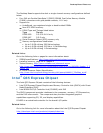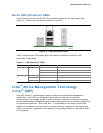Intel Desktop Board DQ35MP Product Guide
22
Intel
®
Rapid Recover Technology
Intel Rapid Recover Technology enables fast and easy recovery of your data in the
event of a hard drive failure. It allows you to maintain a complete copy of your
primary or master drive onto a second hard drive, the recovery drive. If the master
hard drive should fail, either from a mechanical failure or the result of a virus,
recovery is as simple as booting from the recovery drive. The recovery drive can be
attached to your system via any standard SATA or eSATA connection.
Intel Rapid Recover Technology also provides the added benefit of allowing the
recovery drive to be mounted as a read-only volume so you can quickly copy files from
the recovery drive when individual files need to be recovered.
For information on configuring your system for Intel Rapid Recover Technology see
Chapter 5.
Expandability
For system expansion, the Desktop Board provides the following expansion slots:
• Two PCI Express x1 connectors
• One PCI Express x16 connector
• One PCI bus connector
BIOS
The BIOS provides the Power-On Self-Test (POST), the BIOS Setup program, the
PCI/PCI Express and IDE auto-configuration utilities, and the video BIOS. The BIOS is
stored in the Serial Peripheral Interface (SPI) Flash.
The BIOS can be updated by following the instructions on page 67 in Chapter 3.
Serial ATA and IDE Auto Configuration
If you install a Serial ATA or IDE device (such as a hard drive) in your computer, the
auto-configuration utility in the BIOS automatically detects and configures the device
for your computer. You do not need to run the BIOS Setup program after installing a
Serial ATA or IDE device. You can override the auto-configuration options by
specifying manual configuration in the BIOS Setup program.
PCI* and PCI Express* Auto Configuration
If you install a PCI/PCI Express add-in card in your computer, the PCI/PCI Express
auto-configuration utility in the BIOS automatically detects and configures the
resources (IRQs, DMA channels, and I/O space) for that add-in card. You do not need
to run the BIOS Setup program after you install a PCI/PCI Express add-in card.


















